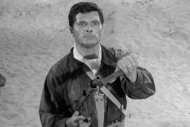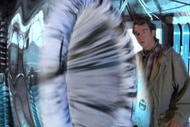Create a free profile to get unlimited access to exclusive videos, sweepstakes, and more!
Why Penny Dreadful, for all its faults, is the greatest television drama ever

Four years after the third and final season of Showtime's Penny Dreadful, creator John Logan is about to reboot the series with Penny Dreadful: City of Angels. The new season will feature an entirely new cast and a new setting in a Mexican-American community of Los Angeles. The trailer looks intriguing — but it will be difficult for this fourth season to rival the original, which was simply, in my opinion, the best serialized television drama ever.
Penny Dreadful isn't usually accorded such accolades. It's rarely mentioned in the top tier of critically acclaimed television like The Wire, Deadwood, The Sopranos, Mad Men, Breaking Bad, or the like. But Logan and his stellar cast managed to create a series that both took advantage of serialized television's weaknesses and transcended the medium's strengths. An amalgam of poetry and pulp, horror and romance, Penny Dreadful was at once giddily exploitative and heartbreaking — a series filled with, in its own words, "beautiful monsters" and "dreadful, gorgeous things."
The series features a melange of original characters and figures borrowed from the works of Bram Stoker, Mary Shelley, Oscar Wilde, and more. The main protagonist is Vanessa Ives, played by an incandescently scene-chewing Eva Green. Vanessa looks like a proper lady in Victorian London, and she is by turns wise, kind, and flirtatious. But she is also a bundle of lust, guilt, and anger, sought by Dracula and Satan, who both want to seduce her and use her supernatural powers to bring about an apocalypse of poisonous air and bestial darkness.
Vanessa is aided against the forces of the night by adventurer Sir Malcolm Murray (Timothy Dalton), American sharpshooter and werewolf Ethan Chandler (Josh Hartnett), as well as doctor and researcher Viktor Frankenstein (Harry Treadaway). Frankenstein (as you might've guessed) has also been experimenting with bringing dead bodies back to life. His first reanimated Creature (Rory Kinnear) terrorizes him into making another, Lily (Billie Piper), who, by the third season, is raising an army of sex workers to overthrow society.
As with any serialized television narrative, the plot is convoluted, with much to be said about certain events' often-improbable tangles. Vanessa Ives and the Creature meet each other for the first time more than once thanks to convenient bouts of amnesia, as just one example.
But convenient plot twists and bloat plague even the best television dramas. Twin Peaks famously lost its way for a bit after the Laura Palmer murder was solved, and The Wire got bogged down on the docks in its fourth season. Penny Dreadful, though, luxuriates in the slithering, crawling melodramatic excess of meandering.
The series' aesthetic is baroque, and the pleasure of watching is as much about relishing each heightened moment of woe and fear and joy as it is about finding out what is going to happen next. One first-season episode is given over entirely to Vanessa being possessed by the devil; the narrative stalls out as all the characters gather around to watch Eva Green writhe and spit and snarl, her stick-thin arms crawling and bending like spider's legs.
You're supposed to watch Penny Dreadful the way one of Victor's creations — a gentle reanimated corpse named Proteus (Alex Price) — discovers the pleasure of eating chestnuts; or the way Dorian Gray (Reeve Carney) caresses a flower; or the way Dracula (Christian Camargo) describes the lovely albinism of a deadly scorpion. The very first scene of the series, the brutal dismemberment of a pregnant mother snatched from the toilet, is never fully explained, nor much pursued. It's a pure, beautiful, bloody jump scare filigree for its own sake — one of the "overly Byzantine dalliances" of which the flamboyant Egyptologist Ferdinand Lyle (Simon Russell Beale) boasts.
Part of the wonder of the "overly Byzantine dalliances" is the phrase "overly Byzantine dalliances" itself. The series drips with poetry — quotations from Tennyson and Wordsworth and Shelley and John Clare, but also original dialogue with the richness of verse.
"The monster is not in my face, but in my soul… The malignance has grown from the outside in, and this shattered visage merely reflects the abomination that is my heart," the Creature declares.
"If you've been touched by the demon, it's like being touched by the backhand of God," says a surprisingly eloquent priest.
"We flatter men with our pain," Lilly Frankenstein spits at a haunted Viktor, her former master.
Many of the most indelible impressions of the series are not scenes, but the way the actors say their lines: Kinnear's heavy pauses; Billie Piper's sensual use of the bottom of her vocal range; Timothy Dalton's gravelly rumble; Eva Green's precise, clipped phrases, which act as either flirtatious scratches or painful punctures; Reeve Carney's cultured ease as he tells Vanessa to "endure uniqueness."
The series slides from soliloquy to soliloquy like a Shakespeare play. No other series on television has ever loved words and the rhythms of speech as much as Logan’s original show did. The series' elevated language gives it, like so many of its characters, a kind of double life.
On the surface, the show is a pulp penny dreadful, fascinated with blood and sex and dramatic frights. But a show that ends with a long quotation from Wordsworth at a graveside is also in conversation with high art in a way rare in popular culture. Penny Dreadful picks up the highbrow/lowbrow tradition from snooty pulpy romance horrors like The Picture of Dorian Gray and Frankenstein — both, not coincidentally, stories about secrets, the closet, and hidden depths.
"There are such sins at my back," says Ethan Chandler, "it would kill me to turn around."
The shifting of modes between poetic and bloody, grotesque and elevated, allows Logan to show his character's hidden selves with a rare deftness and conviction.
Practically everyone gets to play Satan at one point or another. Practically everyone, man or woman, sleeps with Dorian Gray, without anyone else knowing. Viktor plays a minor, stalwart ally against evil in Vanessa's story. In his own plot, though, he's the conscienceless supervillain, egotistical and ruthless. The Creature is a tormented poet and a serial killer; Vanessa is a young girl desperate for love and also the Mother of Evil. Each character is a pulp hero and a broken thing, a silly caricature spouting sublime poetry.
"All the broken and shunned creatures. Who's going to care for them if not us?" Dracula asks Vanessa while disguised as a humble, nerdy museum caretaker. The dread lord of the night is expressing sympathy for people with strange powers and people with sexual desires. He's siding with gay people and disabled people, and also with vampires cast out of heaven. But he's also talking about misshapen stories, those that don't fit into one exhibit or another but skitter from gallery to gallery with clumsy grace. In a way, he's talking about the show itself.
In Penny Dreadful, poetry is stapled to the Grand Guignol theater, and television hangs in Dorian Gray's exquisite, mysterious art gallery. The series is too hybrid a patchwork thing to be celebrated as it should, perhaps. But I'm glad to see it rise from the dead, to endure uniqueness once more.
The views and opinions expressed in this article are the author's, and do not necessarily reflect those of SYFY WIRE, SYFY, or NBCUniversal.































